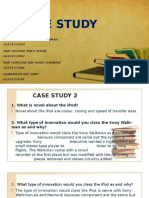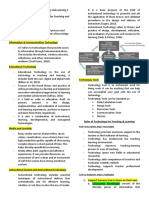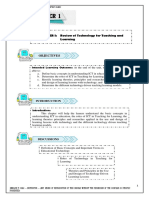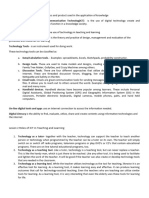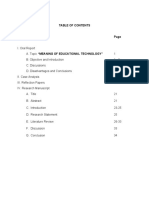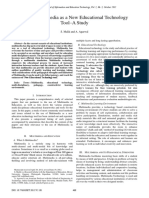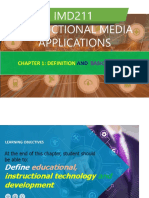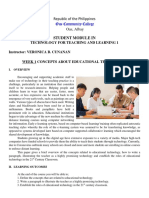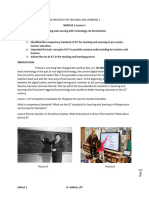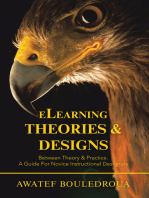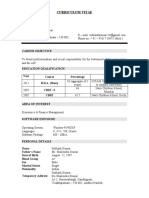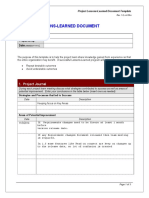0 ratings0% found this document useful (0 votes)
3 viewsEduc 4 Midterm Reviewer
Educ 4 Midterm Reviewer
Uploaded by
ajdeuna16Copyright:
© All Rights Reserved
Available Formats
Download as PDF, TXT or read online from Scribd
Educ 4 Midterm Reviewer
Educ 4 Midterm Reviewer
Uploaded by
ajdeuna160 ratings0% found this document useful (0 votes)
3 views15 pagesOriginal Title
EDUC 4 MIDTERM REVIEWER
Copyright
© © All Rights Reserved
Available Formats
PDF, TXT or read online from Scribd
Share this document
Did you find this document useful?
Is this content inappropriate?
Copyright:
© All Rights Reserved
Available Formats
Download as PDF, TXT or read online from Scribd
Download as pdf or txt
0 ratings0% found this document useful (0 votes)
3 views15 pagesEduc 4 Midterm Reviewer
Educ 4 Midterm Reviewer
Uploaded by
ajdeuna16Copyright:
© All Rights Reserved
Available Formats
Download as PDF, TXT or read online from Scribd
Download as pdf or txt
You are on page 1of 15
EDUC 4: TECHNOLOGY FOR TEACHING & LEARNING 1 REVIEWER
INTRODUCTION TO TECHNOLOGY IN TEACHING INSTRUCTIONAL TECHNOLOGY: is the theory and
BASIC UNDERSTANDING OF ICT IN EDUCATION practice of design, development, utilization, management,
TECHNOLOGY: refers to a mix of process and product and evaluation processes and resources for learning.
used in application of knowledge. It can be electronic or EXAMPLES OF EDUCATIONAL TECHNOLOGY
tools for practical tasks. can be digital or non-digital, it PRODUCTIVITY TOOLS: any type of software
can be electronic or tools for practical tasks. associated with computers and related technologies that
DIGITAL TECHNOLOGY: are part of information and can be used as tools for professional and classroom
communication technology. productivity.
ICT (INFORMATION & COMMUNICATION EXAMPLES OF INSTRUCTIONAL TECHNOLOGY
TECHNOLOGY): UNESCO (2021) diverse set of TRADITIONAL CLASSROOM: where a teacher
technological tools and resources used to transmit, store, moderates and regulates the flow of information and
create, share or exchange information. These knowledge.
technological tools and resources include computers, the FLIPPED CLASSROOM: a teaching approach
Internet (websites, blogs and emails), live broadcasting in which direct instruction (lecture) is introduced to
technologies (radio, television and webcasting), recorded contents at home while practice or apply it in school.
broadcasting _____________________________________
technologies (podcasting, audio and video players and ROLE OF ICT IN EDUCATION
storage devices) and telephony (fixed or mobile, satellite, ROLE OF TECHNOLOGY IN TEACHING & LEARNING
video-conferencing, etc.). According to Stosic (2015), education technology plays
GOAL OF ICT: ICT literacy & digital literacy. three domains:
ICT LITERACY: the use of digital technology, 1. Technology as a tutor.
communication tools, and/or networks to access, 2. Technology as a teaching tool.
manage, integrate, evaluate, create, and communicate 3. Technology as a learning tool.
information to facilitate the knowledge of society (Guro21, I. TECHNOLOGY AS A TUTOR
2011) Technology can support teachers to teach another
DIGITAL LITERACY: the ability to find, evaluate, utilize, person. When programmed, technology can tutor
share, and create contents using information students on its own. Best examples of which are TV
technologies and the internet. programs, playing DVD’s. and online tutorials on
DIGITAL LEARNING: any type of learning that is YouTube.
accompanied by technology or by instructional practice II. TECHNOLOGY AS A TEACHING TOOL
that makes effective use of technology. Technology is a teaching tool but can never replace a
EDUCATIONAL TECHNOLOGY: refers to the use of teacher. Like any other tool, it’s used should lighten the
technology in teaching and learning. It includes
non-digital and digital tools.
EDUC 4: TECHNOLOGY FOR TEACHING & LEARNING 1 REVIEWER
work of the teacher. It will be good if the teacher can also Egbert (2009) classified the three categories of
create or develop technology tools that are needed in the knowledge as the following:
classroom. A. DECLARATIVE KNOWLEDGE: Consists of
The following are the uses of technology in discrete pieces of information that answers 4 W's
teaching: (Who, What, When, Why). These are
a. Technology provides enormous support to the fundamental knowledge necessary to achieve
teacher as a facilitator of learning. Higher order thinking skills and are learned
b. Technology has modernized the teaching through memorization, drills, and practice.
learning environment. B. STRUCTURAL KNOWLEDGE: Consists of facts
c. Technology improves the teaching-learning and declarative information put together to attain
process and ways of teaching. some form of meaning. It can be presented by a
d. Technology opens new fields in educational concept map, categorization, and classification.
research. C. PROCEDURAL KNOWLEDGE: Consists of
e. Technology adds to the competence of teachers. action or knowledge of how to do something. It is
f. Technology supports teacher professional indicated by a performance task or graphical
development. representation of a concept.
III. TECHNOLOGY AS A LEARNING TOOL ______________________________________________
Technology is an effective tool for learning as it B. ENHANCE LEARNER’S COMMUNICATION
makes learning easy and effective. Using technology in SKILLS THROUGH SOCIAL INTERACTION.
learning may help the students in producing Technology can enhance learners' social interaction with
technology-assisted learning outcomes. others through the transmission of information from one
Teachers may also use technology for learning for the individual to another or groups to another.
following: SOCIAL INTERACTION: occurs in two ways where the
a. Support learners to learn on their own. participants ask for clarifications, argue, challenge each
b. Enhance learner’s communication skills through social other work towards common understanding.
interaction. Social interaction occurs through technology using:
c. Upgrade learner’s higher order thinking skills, critical a. Communication technology (via email, cell phone,
thinking, problem solving and creativity. social media, etc.)
A. SUPPORT LEARNERS TO LEARN ON THEIR b. Solving a problem with the use of a software
OWN c. support of technology in answering printed worksheets
Technology can make students gained knowledge by such as those uploaded online.
doing their personal research at their own time and
Pace.
EDUC 4: TECHNOLOGY FOR TEACHING & LEARNING 1 REVIEWER
Technology enable learners to: (2) introduce new technologies
b.1. Guide by the teacher virtually and make learning (3) modifying learner’s groupings
unlimited even beyond school time. (4) modifying critical thinking tasks
b.2. Express and exchange ideas freely without the (5) encouraging curiosity.
snooping eyes of the teachers. SEVEN CREATIVE STRATEGIES
b.3. Construct meaning from a joint experience with other Osborn (1963) enumerated 7 creative strategies in
participants. teaching which can be simplified as the following:
b.4. Be able to solve problems from multiple sources SUBSTITUTE: finding something to replace to do what it
since there are unlimited resources that teachers can does.
give to learners. COMBINE: blending two things that do not usually go
b.5. Communicate with politeness and send feedback. together.
b.6. Collaborate by using communication strategies with ADAPT: looking for other ways
wider communities in a borderless environment. MODIFY: making a change, enlarge, or decrease
b.7. Develop critical thinking, problem solving, and Put to another use : find another use
creativity through communication ELIMINATE : reduce, remove
_____________________________________________ REVERSE: turn upside down, inside out or front side
C. .UPGRADES LEARNER’S HIGHER ORDER back
THINKING SKILLS, CRITICAL THINKING, PROBLEM ______________________________________________
SOLVING AND CREATIVITY ICT POLICIES & SAFETY
Technology can enhance learners’ critical thinking skills ISSUES ON ICT
by using the internet as a research tool to help answer ISSUE 1: FREEDOM OF EXPRESSION &
questions. CENSORSHIP
CRITICAL THINKING: part of the Higher Order Thinking The UN Declaration of Human Rights provides that
Skills (HOTS) which refers to the ability to interpret, everyone has the right to freedom of thought, conscience
explain, analyze, evaluate, infer and self-regulate in order and religion. Below are the practices that violate this pact.
to make good decisions. a. Individual rights are given up to have access to
Teachers plays a crucial role in developing critical electronic networks. (Photographs, videos, trademarks
thinking to students with the help of technology via: are uploaded on social media and the internet).
a. Asking the right questions: Critical thinking b. Censorship restricts the transmission of information by
questions should ask for clarity, accuracy, precision, blocking or filtering information. (Blocking is preventing
relevance and depth. access to whole areas of the internet based upon a
b. Using critical thinking tasks with appropriate level “blacklist of a certain internet address).
of challenge: These can be done through: c. Defamation may be used to silence critics.
(1) varying the questions asked
EDUC 4: TECHNOLOGY FOR TEACHING & LEARNING 1 REVIEWER
ISSUE 2: PRIVACY & SECURITY c. Shifting of material waste from industrial countries to
Privacy Policies are an issue. Most commercial sites developing countries, using less environmentally
gace a privacy policy in which clicking “I agree” seems to responsible procedure.
turn on your private information to website authorities BELOW ARE THE REMEDIES ON SOLVING
who may access it. E-POLLUTANTS
a. For most, privacy means “personal privacy” which is a. Standardization and regulatory measures to increase
sometimes interfered with. Personal Privacy is the right of the life cycle of the equipment before they become
the individual over their home, private life and personal obsolete.
life. b. Efficient extraction of toxic components.
b. Privacy of communication is hindered. Privacy c. Recycling of both consumers and equipment vendors.
communication is the protection from interference with ______________________________________________
communication over the phone and the internet. NATIONAL & INTERNATIONAL ICT POLICIES IN
c. Information privacy is at risk. Information privacy is EDUCATION
the use of computers and computer systems where
information withhold should not be disclosed with others
without the consent of the individual.
ISSUE 3: SURVEILLANCE & DATA RETENTION
The use of electronic communication has enhanced the
development of indirect surveillance.
DATAVEILLANCE: use of personal information to
monitor a person’s activities. IMPLICATIONS OF USING ICT IN TEACHING &
DATA RETENTION: storage and use of information from LEARNING
communication systems. FOR THE TEACHERS AND TEACHING
ISSUE 4: E-POLLUTANTS FROM E-WASTE a. Guide the teachers on what they should teach that
Large amount of E-waste is generated by ICT. E-waste is relate to ICT, and how to teach it: Temperance in its
terminal equipment for computing such as PC’s, laptops, use it a caution to look at.
TV, radio sets, mobile phones, fax machines, printers, b. Technology should never replace a teacher:
and scanners. Teachers should always be reminded that there are
limitations in the use of gadgets and tech tools.
a. The accumulated E-Waste is due to rapid turnover of c. Apply rules and regulations to govern the use of
equipment due to rapid improvement of software. technology: As teachers, you must be aware that the
b. Toxic materials released in different equipment require use of technology may jeopardize your security and
utmost management. Privacy.
EDUC 4: TECHNOLOGY FOR TEACHING & LEARNING 1 REVIEWER
FOR THE LEARNERS
a. Learners still need guidance from the teacher: GOOD PRACTICES IN USING THE INTERNET
Learners should know the positive and negative effects of The following are some of the good practices when using
using technology. the Internet:
b. Learners should take advantage of the potential of 1. Always keep your software or application updated and
learning support : Using technology, students can uninstall the ones that you do not use.
develop collaboration, HOTS, and manage vast 2. Do not divulge sensitive information online, especially
resources. on unsafe websites.
c. Be mindful that e-waste outgrows the land and 3. Be careful when dealing with emails from unknown
atmosphere. sources or spam
ICT SAFETY, SECURITY, AND NETIQUETTE 4. Run your antivirus software before going online.
INTERNET: is a vast network of computers where many 5. Think before you click. What you post on the Internet
users, content, tools, and resources are made accessible. may stay online forever.
You do homework and research papers with the help of
the Internet. You communicate through the Internet.
COMPUTER ETHICS: concerned with standards of
conduct on the use of computers. It deals with how
computing professionals should make decisions
regarding professional and social conduct.
Following the 1987 memo on ethics of the Internet
Advisory Board, the Computer Ethics Institute created the
Ten Commandments of Computer Ethics in 1992,
introduced by Ramon C. Barquin.
• The more information you put or use online the higher
the risk placed on your online safety. With this, you can
be a victim of IDENTITY THEFT, PHISHING, MALWARE
INFECTIONS, etc.
• It is your responsibility to secure your information online
as well as maintain good etiquette when using these
services.
EDUC 4: TECHNOLOGY FOR TEACHING & LEARNING 1 REVIEWER
LEARNING THEORIES IN EDUCATIONAL ● When students are made to work with others in a
TECHNOLOGY pair or in a team, they are given the chance to
4C’s OF 21ST CENTURY SKILLS practice how to relate with others.
I. CRITICAL THINKING (Finding solutions to BLOOM’S TAXONOMY
problems)
● a type of learning on how to solve problems. It
teaches students not to accept immediate claims
without seeking the truth.
● ability to differentiate facts from opinions and not
only just learn a set of facts or figures but also
learn what it is ought to be
II. CREATIVITY (Thinking outside the box)
● requires students to think out of the box and to
take pride in what is uniquely theirs.
● means that students will be able to look at a
problem from multiple perspectives, can propose
multiple possibilities, and alternatives to address
a problem that they need to take on calculated
risks.
Note: Creativity may not ensure success all the time but DALE’S CONE EXPERIENCES
it may lead to another direction that can actually be a CONE OF EXPERIENCES: designed to show the
better way of figuring out how to solve the problem. progression of learning experience from concrete to
III. COMMUNICATION (Conveying Ideas) abstract.
● makes students express their ideas in the
clearest and organized manner.
● Students must master how to efficiently and
clearly convey ideas either through varied modes
such as face to face, technologically mediated or
a blended medium.
IV. COLLABORATION (Working with others)
● happens when students know how to work well
with others to accomplish a given task or solve a
problem at hand.
EDUC 4: TECHNOLOGY FOR TEACHING & LEARNING 1 REVIEWER
Specimen: an individual animal, plant, piece of a mineral,
etc. It’s used as an example of its species or type for
scientific study or display.
Object: artifacts displayed in a museum or objective
displayed in exhibits or preserved insect specimens in
science.
Simulation: representation of a real manageable event in
which the learner is an active participant engaged in
A. Direct Purposeful Experiences learning behavior or in applying previously acquired skills
● first-hand experiences, involve all of our senses. or knowledge.
● skills we gained in real life through our firsthand, C. Dramatized Experiences
direct involvement. ● “Reconstructed experiences” of reality using role
● best mode, means or channels for hitting your playing.
objectives and competencies (desired outcomes) ● experience gained through active participation
How to do this: Strive to provide the students with real and role-playing in dramatic activities.
life realistic experiences by showing actual objects and ● Its two categories (examples) are Acting &
enabling them to come into direct contact with it Observing.
themselves. ● useful in history, political science, language, and
Examples: allowing students to prepare their meals, literature.
making a PowerPoint presentation, delivering a speech, When to use: can be used to depict the actual events of
performing experiments, or making their own furniture. the past or present or simplify its parts.
B. Contrived Experiences Examples:
● “Editing of reality“ and represented experiences • The plays can be a variety of forms, such as full-length
● These are not very rich, concrete, and direct as a play, one-act play
real-life experience. • Puppet show (shadow puppet, Rod puppet, Glove and
When to use: necessary when real experience cannot be finger puppet, Marionettes,
used or are too complicated • Pageants (a kind of group drama focused on local
Examples: Models, miniatures, mock-ups. history)
Examples of Contrived Experiences • Mime, Tableau, Dialogs,
Models: a replication in a small scale or a large scale or • Spot-spontaneous acting
exact size of a real item- but made of synthetic materials. • Mock conventions
Mockup: an arrangement of a real device or associated
devices displayed in such a way that representation of
reality is created.
EDUC 4: TECHNOLOGY FOR TEACHING & LEARNING 1 REVIEWER
Examples of Dramatized Experiences D. Demonstrations
Plays: depict life, character, culture, or a combination of ● visualized explanation of a significant reality,
the three. They offer opportunities to portray ideas of life concept fact, idea, or process.
(such as liberty, equality, etc.). ● It shows how certain things are done through
Pageants: community dramas that are based on local visual explanation of a process.
history. It is a kind of group drama focused on local ● Students can watch how certain things are done
history. either in the form of actual objects or models.
Pantomime: "method of conveying a story by bodily When to use: Specific complicated procedures can be
gestures." Pantomime's impact on the audience relies on performed by the teacher for the benefit of pupils who are
the actors' movements. reduced to the position of passive listeners.
Tableau: picture-like scene composed of people against E. Study Trips or Field Trips
a background. It is an arrangement of people who do not ● watching people do things in real situations.
move or speak, especially on a stage, who represents a ● a planned point visit or a location outside the
view of life, an event, etc. daily classroom.
Role-Playing: unrehearsed, unprepared, and ● observing an event that is unavailable in the
spontaneous dramatization of a situation where their classroom.
roles absorb assigned participants. ● an organized situation in the form of tours, flights,
Examples of Puppets hikes, and excursions.
Puppet: inanimate object or representational figure When to use: To provide the students with valuable
animated or manipulated by an entertainer, who is called opportunities to offer direct real-life experiences.
a puppeteer. Puppets can present ideas with extreme Examples of Study Trips or Field Trips
simplicity. • Science Museum Trip
Glove & Finger Puppets: use of gloves in which small • Historical Reenactment Trip - Living History Field Trip
costumed figures are attached. • Eco-Adventure Trip - Biology Field Trip
Marionettes: flexible, jointed puppet operated by strings • Museum of Natural History Trip
or wires attached to a crossbar and maneuvered from • Reward Trip - Celebration/Fun Field Trip
directly above the stage. • Aviation Museum Trip - Military History Field Trip
Rod Puppets: flat, cut-out figures tacked to a stick with • Heritage Museum Trip- Culture Field Trip
one or more movable parts and are operated below the • Historic Church Trip - Religious Field Trip
stage through wires or rods. F. Exhibits
Shadow Puppets: flat, black silhouette made from ● something seen by a spectator. It can be viewed,
lightweight cardboard shown behind a screen. manipulated, or interactive. It is the concrete
representation of the things.
EDUC 4: TECHNOLOGY FOR TEACHING & LEARNING 1 REVIEWER
● less real or direct in terms of providing direct Examples: graph, flowchart, maps, sketches, posters,
practical experience. Many exhibitions are “only comics, photos, drawing on blackboards, illustrations, and
for your eyes.” . diagrams.
When to use: Use when the teacher can help the Examples of Visual Symbols
students by gaining useful experience through the 1.1 Drawing: a picture or diagram made using pen,
observation and organization of educationally significant pencil and crayon. It might not be a real thing, but it will
exhibitions. help to prevent ambiguity.
Examples: consist of organized working models or 1.2 Strip Drawing: a series of sketches linked to a funny
photographs of templates, maps, and posters. story or an adventure in a newspaper, magazine, etc .
G. Motion Pictures and Television 1.3 Cartoons: a picture or drawing intended in a
● two-dimensional reconstruction of reality humorous way. Metaphorically a first-rate cartoon reveals
When to use: allows the learners to experience the its story.
situation being communicated through the mediated 1.4 Diagrams: any line drawing that shows arrangement
tools. Television and movie clips can so expertly recreate and relations as of parts to the whole, relative values,
the history of the past,that we have to feel like we’re origins and development, chronological fluctuations,
there. distributions, etc. ( Dale, 1969)
H. Still Pictures, Recordings and Radio Examples of Diagrams
● includes the number of devices that might be Fishbone Diagram: visualization method for categorizing
classified roughly as one-dimensional aids the possible causes of the root cause of the issue.
because they use only one sense organ that is Affinity Diagram: used to cluster complex apparently
either eye (seeing) or ear (hearing). unrelated data into natural and meaningful groups.
● Still pictures are materials that are less direct Tree Diagram: used to cluster complex apparently
than audiovisual experiences. unrelated data into natural and meaningful groups.
● It can often be understood by those who cannot 1.5 Charts: diagrammatic representation of individual
read. connections within an organization.
When to use: helpful to students who cannot deal with Examples of Charts
the motion or pace of a real event or television. Time Chart: tabular time diagram displaying data in
I. Visual Symbols ordinal series.
● abstract representation of the concept of the Tree or Stream Chart: shows creation, growth and
information. change starting with a simple course spreading out over
● These are no longer practical reproductions of several branches.
material objects and are incredibly abstract. Flowchart: visual way of showing a process from
beginning to end.
EDUC 4: TECHNOLOGY FOR TEACHING & LEARNING 1 REVIEWER
Organizational Chart: shows how one part of the J. Verbal Symbols
company applies to other sections ● written words (symbols, codes, formula) or
1.6 Graph: a diagram showing the relationship between spoken words in the classroom.
the variable quantities, usually two variables, each ● To express any meaning, verbal representations
calculated at the right angles along with one of a pair of are words, phrases, sounds, or other utterances
axes. that are spoken aloud.
Examples of Graphs ● It might be an idea (freedom of speech), a
Circle Graph: visual representation of data made by scientific principle (Law of Gravity), a formula
dividing a circle into sectors that each represent parts of a (e=mc2).
whole. Examples: phrase, an idea, a concept, a scientific theory,
Bar Graph: used to compare the magnitude of the same a formula, a philosophical aphorism, published terms.
things at different relations or to see the relative sizes of Summary of Cone of Experiences
the entire pieces. Direct Purposeful Experiences (first-hand
Pictorial Graph: visual representation of data by using experiences): experiences with the least abstractness
pictograms. and maximum possible concreteness.
1.7 Graphic Organizers: pedagogical method that uses Contrived Experiences (substituted experiences):
visual symbols to communicate knowledge and concepts used as a substitute of a direct experience.
through interactions between them. Dramatized Experiences: reconstruct an experience
1.8 Maps: reflection of the earth's surface or a part through active participation such as role playing and
thereof. dramatization.
Examples of Maps Demonstrations: actual execution of a procedure to
Physical Map: shows altitude, temperature, precipitation, make the experience meaningful.
rainfall, vegetation, and soil. Study Trips: actual visits to a certain location to observe
Relief Map: three dimensional represents and shows a situation or a case which may not be available inside
contours of the physical data of the earth or part of the the classroom.
earth. Exhibits: viewed displays of models which provide the
Political Map: display of the geographical boundaries message or information.
between units of government, such as nations, states, Televisions and motion pictures (two-dimensional
and counties. experience): technology equipment that provides two
1.9 Posters: any large printed picture, photograph, or dimensional reconstruction of a reality.
notice that you stick or pin to a wall or board, usually for Still pictures, recordings, and radio: Still are pictures
decoration or to advertise something. or images. These include audio-recorded materials or
information broadcast through radio.
EDUC 4: TECHNOLOGY FOR TEACHING & LEARNING 1 REVIEWER
Visual symbols: abstract representations of the concept ● perception is separated from the world of science
or information. and limited to two or three senses.
Verbal symbols: the most abstract as they are symbols, Symbolic Experience
words, codes or formulae. ● using the images we internalized and turn them
BRUNER’S THREE-TIERED MODEL into abstract language, such as mathematical
symbols.
● involves reading or hearing symbols (the student
learns or hears the word “knot” and forms an
image in mind).
● the action is removed nearly altogether, and the
experience is limited to thoughts and ideas.
THE TPACK FRAMEWORK
TPACK FRAMEWORK
Who is Jerome Bruner? ● Puny Mishra and Matthew J. Koehler (2006)
● the “inventor of Spiral Curriculum” and ● describes the kinds of knowledge needed by a
“scaffolding technique” . teacher for effective technology integration.
● was born blind in New York City in 1915. At age ● Gives structure to our classrooms to provide the
two, modern medicine restored his vision. best educational experience for students while
● He believed that “any subject can be taught in an incorporating technology.
intellectually honest form to any child at any 1. Pedagogical Knowledge: knowledge about the
stage of development” . processes and practices or methods. It refers to
Enactive Experience how a teacher is going to essentially teach a
● happens in hands-on experiences, ideally with specific content area to their students.
real world applications. (strategies, methods, approach).
● includes working with objects (the student joins a 2. Content Knowledge: an educator’s
knot to practice knot tying). understanding and proficiency of the subject area
● requires direct action and effective use of the that they teach. (facts, contents, theories).
senses and the body. 3. Technological Knowledge: an educator’s
Iconic Experience knowledge of how to properly integrate
● linking memories of the experience to create technology into their classroom. This means that
iconic pictures. the teacher is using technology in a way that will
● includes reading photos and sketches (the promote academic success and will truly benefit
student looks at paintings, pictures, or movies to their students.
learn how to tie knots).
EDUC 4: TECHNOLOGY FOR TEACHING & LEARNING 1 REVIEWER
4. Pedagogical Content Knowledge: • Using Google, Microsoft One drive among others for
understanding the best practices for teaching submission of assignments
specific content to your specific students. AUGMENTATION: technology is again directly
5. Technological Content Knowledge: – knowing substituted for a traditional tool or method, but with
how the digital tools available to you can significant enhancements to the student experience.
enhance or transform the content, how it’s Examples:
delivered to students, and how your students can • Adding comments or annotations to a digital document.
interact with it. • Using educational apps that provide immediate
6. Technological Pedagogical Knowledge: feedback to students' responses.
understanding how to use your digital tools as a • Using interactive digital assessments within
vehicle to the learning outcomes and presentation such as online polls
experiences you want. • Embedding online quizzes links in presentations
• Students give more informative and engaging oral
presentations accompanied by a PowerPoint or Prezi
containing multimedia elements.
MODIFICATION: technology is used to design interactive
and dynamic tasks that go beyond the limitations of a
traditional classroom. Technologically modified tasks also
allow students to generate inspired and innovative work
that isn’t confined to paper.
SAMR Model by Dr. Ruben Puentedura Examples:
SUBSTITUTION: technology is directly substituted for a • Collaboratively editing a document in real-time using
more traditional teaching tool or method. It is a simple, cloud-based tools like Google Docs, allowing multiple
bare-bones, direct replacement. users to contribute simultaneously.
Examples • Teachers implement a flipped classroom model where
• Using a word processing software instead of writing with students watch instructional videos at home and use
pen and paper. class time for handson activities and discussions.
• Watching a video online instead of a live demonstration. REDEFINITION
• Typing your objectives in PowerPoint slides instead of ● It is the pinnacle of how integrated classroom
MS Word. technology can transform a student’s experience.
• Typing their responses or essays using Microsoft Word ● It sees you using technology to make entirely
instead of paper. new learning opportunities possible.
• Uploading pdfs, documents on Google drive for students ● Has the potential to connect learning with the real
to access. world and produce authentic outcomes.
EDUC 4: TECHNOLOGY FOR TEACHING & LEARNING 1 REVIEWER
● It also gives students strong technological soft
skills such as digital collaboration,
communication, technological literacy, and the
ability to adapt to new systems and processes.
Examples:
• Collaborating with students from another country using
video conferencing technology to discuss cultural
differences and similarities, fostering global citizenship.
• Creating multimedia presentations incorporating audio,
video, and interactive elements, allowing students to
demonstrate their understanding of complex concepts in
creative ways.
• Creating a parody song or digital artwork interpretation
of the topic.
ASSURE MODEL
● a guide in crafting an instructional flow that can
guide the teacher in integrating appropriate
technology and media into instructional
processes.
● a systematic approach that teachers can use
when writing their lesson plans.
● procedural guide for planning and delivering
instructions that integrates media into the
teaching process.
● model that can be used by all presenters.
EDUC 4: TECHNOLOGY FOR TEACHING & LEARNING 1 REVIEWER
EDUC 4: TECHNOLOGY FOR TEACHING & LEARNING 1 REVIEWER
You might also like
- 10515-0413-4200 Operacion PDFDocument345 pages10515-0413-4200 Operacion PDFSaul Tula100% (4)
- Roles of Ict For Teaching and Learning: Prepared By: Arlyn Vasquez Operia Chrisjohn de Guzman PulaDocument22 pagesRoles of Ict For Teaching and Learning: Prepared By: Arlyn Vasquez Operia Chrisjohn de Guzman PulaMaria Elena Baslot100% (8)
- Lesson 1 - Introduction To Technology For Teaching and LearningDocument33 pagesLesson 1 - Introduction To Technology For Teaching and LearningWisley Jay Solayao81% (16)
- GetYourGuide Weekly Partner Forum CW 21 ShareoutDocument51 pagesGetYourGuide Weekly Partner Forum CW 21 ShareoutPanorama LuxNo ratings yet
- Inno PresentationDocument6 pagesInno PresentationAmisha Aliena60% (5)
- 16 Bit AdderDocument4 pages16 Bit AdderNilesh Maurya100% (1)
- Computer HardwareDocument18 pagesComputer HardwareArtur100% (144)
- Educ 4 ReviewerDocument5 pagesEduc 4 Reviewerajdeuna16No ratings yet
- Module Technology 1Document8 pagesModule Technology 1Catherine Ronquillo BalunsatNo ratings yet
- Unit 1 - Introduction To Technology For Teaching and LearningDocument3 pagesUnit 1 - Introduction To Technology For Teaching and Learninglisa71% (7)
- WhatDocument5 pagesWhatrachelle& allaineNo ratings yet
- CHAPTER I: Review of Technology For Teaching and LearningDocument16 pagesCHAPTER I: Review of Technology For Teaching and LearningTavi De Jesus RoaNo ratings yet
- Educ 103 Module 4 Lesson3Document7 pagesEduc 103 Module 4 Lesson3rocelp72No ratings yet
- TTL PointesDocument6 pagesTTL PointesWella SuaNo ratings yet
- Educ85 Week2Document26 pagesEduc85 Week2lisaNo ratings yet
- Technology For Teaching and Learning 1Document5 pagesTechnology For Teaching and Learning 1Leonelyn CaraNo ratings yet
- TL1 Notes (1ST Sem - Midterm)Document9 pagesTL1 Notes (1ST Sem - Midterm)Julyah PicardalNo ratings yet
- CHAPTER 1: Introduction To Technology For Teaching and Learning Lesson 3: Roles of Technology For Teaching and LearningDocument2 pagesCHAPTER 1: Introduction To Technology For Teaching and Learning Lesson 3: Roles of Technology For Teaching and LearningErika Mae TupagNo ratings yet
- Educational Technology Portfolio 101Document37 pagesEducational Technology Portfolio 101Reading HubNo ratings yet
- Detailed Lesson Plan TemplateDocument5 pagesDetailed Lesson Plan TemplateSwychine PioncioNo ratings yet
- Use of Multimedia As A New Educational TechnologyDocument4 pagesUse of Multimedia As A New Educational TechnologyArsip Mahasiswa100% (1)
- Role of Technology in Indian Education: AbstractDocument5 pagesRole of Technology in Indian Education: AbstractVidhu VasavNo ratings yet
- Unit 1 Prof Ed 4Document5 pagesUnit 1 Prof Ed 4Ivan George SantiagoNo ratings yet
- Engagement, by Facilitating The Acquisition of Basic Skills, and by Enhancing Teacher Training. Icts AreDocument3 pagesEngagement, by Facilitating The Acquisition of Basic Skills, and by Enhancing Teacher Training. Icts AreAbby MclidNo ratings yet
- Ed 207 - TTL 1 Unit 4Document12 pagesEd 207 - TTL 1 Unit 4kimpeterjohnlebunaNo ratings yet
- Lesson 3 Roles of Technology For Teaching and LearningDocument4 pagesLesson 3 Roles of Technology For Teaching and LearningBeby Jane CenizaNo ratings yet
- TTL PPT - 031508Document33 pagesTTL PPT - 031508Palo PaloNo ratings yet
- Introduction To Technology For Teaching and LearningDocument26 pagesIntroduction To Technology For Teaching and LearningsophiarhedgNo ratings yet
- Chapter 1Document30 pagesChapter 1GabriellllllNo ratings yet
- Oas Community College: Student Module inDocument7 pagesOas Community College: Student Module inKim NoblezaNo ratings yet
- Module 1 BTLED 2Document20 pagesModule 1 BTLED 2irishjane.tabelismaNo ratings yet
- Week1 Module Educ8 Reambonanza, Riza D.Document5 pagesWeek1 Module Educ8 Reambonanza, Riza D.Riza Reambonanza100% (1)
- ReviewerDocument10 pagesReviewerIvana TenorioNo ratings yet
- Roles of Technology For Teaching and LearningDocument36 pagesRoles of Technology For Teaching and LearningApple mae EjorangoNo ratings yet
- EDUC 7 Module 1Document3 pagesEDUC 7 Module 1Prinz Pabz Espanola100% (1)
- E PortfolioDocument28 pagesE Portfolioraymartcasimero57No ratings yet
- Oas Community College: Student Module inDocument7 pagesOas Community College: Student Module inLopez AeraNo ratings yet
- Technology For Teaching and LearningDocument14 pagesTechnology For Teaching and LearningAlrasid SagaisNo ratings yet
- NEO, RALPH LOWIE L., BSED-3-Social Studies, TT1, Module 1Document7 pagesNEO, RALPH LOWIE L., BSED-3-Social Studies, TT1, Module 1Ralph Lowie NeoNo ratings yet
- Handouts Introduction To Technology For Teaching and LearningDocument3 pagesHandouts Introduction To Technology For Teaching and LearningKhemme Lapor Chu Ubial100% (3)
- Module 1-Lesson 2Document6 pagesModule 1-Lesson 2Kel LumawanNo ratings yet
- Introduction and Module 1 (TTL)Document8 pagesIntroduction and Module 1 (TTL)Kristine Castle100% (1)
- Ped7 ReportDocument3 pagesPed7 ReportHa PiNo ratings yet
- Chapter 3Document15 pagesChapter 3Daisy ObisoNo ratings yet
- Semi Detailed Lesson Plan in Educational TechnologDocument9 pagesSemi Detailed Lesson Plan in Educational Technologmarita dolormenteNo ratings yet
- Social Science 504 CUESDocument80 pagesSocial Science 504 CUESDarylNo ratings yet
- Syllabus TTL 101Document6 pagesSyllabus TTL 101Louie AngelesNo ratings yet
- Introduction To Technology For Teaching and Learning: - Commission On Instructional Technology, USADocument4 pagesIntroduction To Technology For Teaching and Learning: - Commission On Instructional Technology, USA서재배No ratings yet
- Yunit Iv EvaluationDocument6 pagesYunit Iv EvaluationDesiree FernandezNo ratings yet
- Edtech LP IcaoDocument4 pagesEdtech LP IcaoICAO JOLINA C.No ratings yet
- Roles of Technology For Teaching and LearningDocument5 pagesRoles of Technology For Teaching and LearningNaprel TalagtagNo ratings yet
- Teaching and Learning With Technology (TTL)Document6 pagesTeaching and Learning With Technology (TTL)Jana RaeNo ratings yet
- ED 8 (Lessons Module 1&3)Document11 pagesED 8 (Lessons Module 1&3)Elisan MarilouNo ratings yet
- Jose Rizal University: Answer The Following Questions ComprehensivelyDocument3 pagesJose Rizal University: Answer The Following Questions ComprehensivelyElizabeth Rio0% (1)
- Ict - Group 1 Pec 104Document48 pagesIct - Group 1 Pec 104Joycee DelossantosNo ratings yet
- Module For PrelimDocument13 pagesModule For PrelimRodelLaborNo ratings yet
- ED 201 STUDY GUIDE 1 UpdatedDocument9 pagesED 201 STUDY GUIDE 1 UpdatedQue QueNo ratings yet
- Technology in Teaching and LearningDocument20 pagesTechnology in Teaching and LearningCris JanNo ratings yet
- Module in Technology For Teaching Learning 1.docx Final - docx1.Docx2.Docx3.Docx4.Docx5.Docx6 CoDocument65 pagesModule in Technology For Teaching Learning 1.docx Final - docx1.Docx2.Docx3.Docx4.Docx5.Docx6 Coanna.mary.arueta.gintoro03120250% (2)
- ED 8 (Lessons Module 1&3)Document11 pagesED 8 (Lessons Module 1&3)Elisan MarilouNo ratings yet
- NadiaDocument14 pagesNadiaJoseph Ignatius LingNo ratings yet
- Edtech 1 H. Vallota, LPTDocument7 pagesEdtech 1 H. Vallota, LPTedgardocabarrubias02No ratings yet
- Module 1 Lesson 1-Teaching and Learning With Technology-An IntroductionDocument3 pagesModule 1 Lesson 1-Teaching and Learning With Technology-An IntroductionJel Lyn DGNo ratings yet
- Educ 201a Group 1Document51 pagesEduc 201a Group 1MaryAnna MarquesesNo ratings yet
- Elearning Theories & Designs: Between Theory & Practice. a Guide for Novice Instructional DesignersFrom EverandElearning Theories & Designs: Between Theory & Practice. a Guide for Novice Instructional DesignersNo ratings yet
- Website Development ProposalDocument5 pagesWebsite Development Proposalabacusdotcom100% (1)
- Engineeringinterviewquestions Com Virtual Reality Interview Questions Answers PDFDocument5 pagesEngineeringinterviewquestions Com Virtual Reality Interview Questions Answers PDFKalyani KalyaniNo ratings yet
- Enterprise Data WarehousingDocument4 pagesEnterprise Data WarehousingKusumastuti WiratnaningtyasNo ratings yet
- Level 1 and Wocrm: User Information GuideDocument6 pagesLevel 1 and Wocrm: User Information GuideBen BieberNo ratings yet
- Computer BasicsDocument26 pagesComputer BasicsSivasakti Marimuthu100% (1)
- Scalar I6000 Datasheet (DS00417A)Document2 pagesScalar I6000 Datasheet (DS00417A)Ahmed MallouhNo ratings yet
- Voice Based Email System Application For Blind and Visually Impaired PeoplesDocument3 pagesVoice Based Email System Application For Blind and Visually Impaired PeoplesE JanviNo ratings yet
- Java Naming Conventions - JavatpointDocument7 pagesJava Naming Conventions - JavatpointThiago Barbosa SoaresNo ratings yet
- What's New in Pro Tools 12.3Document21 pagesWhat's New in Pro Tools 12.3lababazulNo ratings yet
- Requirements Specification Library Management SystemDocument19 pagesRequirements Specification Library Management SystemSuchiNo ratings yet
- HPE Cloud SecurityDocument53 pagesHPE Cloud Securitydanilo parragaNo ratings yet
- Telnet Session Trouble ShootingDocument25 pagesTelnet Session Trouble ShootingandresNo ratings yet
- Subhash ResumeDocument2 pagesSubhash ResumemuralikonathamNo ratings yet
- Manual Estereo CarroDocument108 pagesManual Estereo Carroomarcovic100% (1)
- Toro Aladdin Dongles Monitor 64 Bit PDFDocument3 pagesToro Aladdin Dongles Monitor 64 Bit PDFDawnNo ratings yet
- Baseline Switch 2226-SFP Plus - v1.0.1.16 - RNDocument3 pagesBaseline Switch 2226-SFP Plus - v1.0.1.16 - RNMichel KroonNo ratings yet
- Data Communication & Networking Syllabus (2009-10) MSBTEDocument38 pagesData Communication & Networking Syllabus (2009-10) MSBTERanjeetSangleNo ratings yet
- Redis TutorialDocument110 pagesRedis TutorialKamal LakisNo ratings yet
- Helpful Aspen TutorialDocument64 pagesHelpful Aspen Tutorialjeffbush23No ratings yet
- PR - Aplikom Luluk Hibani Rafiah Si Farmasi B Sem 1 Karya Ilmiah Sudah Jadi DapusnyaDocument23 pagesPR - Aplikom Luluk Hibani Rafiah Si Farmasi B Sem 1 Karya Ilmiah Sudah Jadi DapusnyaKyla AnggraeniNo ratings yet
- Network FundamentalDocument89 pagesNetwork FundamentalelshadayNo ratings yet
- Atmega Bench Power SupplyDocument31 pagesAtmega Bench Power SupplySougata Das100% (2)
- Performance Management With NgeniusoneDocument3 pagesPerformance Management With NgeniusoneErnesto MorenoNo ratings yet
- Lessons Learned TemplateDocument3 pagesLessons Learned TemplateKrishna A100% (1)
- Cracking Linux Passwords and Pentesting With Grep2Document17 pagesCracking Linux Passwords and Pentesting With Grep2kashif majeed janjuaNo ratings yet




